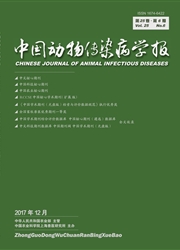

 中文摘要:
中文摘要:
Toll样受体家族(Toll-like receptors,TLRs)作为一种膜表面分子,是模式识别受体(pattern recognition receptors,PRRs)的主要组分,在脊椎动物和无脊椎动物中都可识别入侵的病原体相关分子模式(pathogen associated molecular patterns,PAMPs)。通过对鸡和斑胸草雀的基因组进行比对分析,发现禽中存在10种Toll样受体,其中TLR2 a、b、3、4、5和7已经证明和哺乳动物同源;有些经过基因倍增生成两个基因,TLR1La和TLR1Lb,TLR2 a和2 b;禽TLR21可能与鱼类和两栖动物的同源;禽TLR15是禽类特有的一类受体。各种禽Toll样受体在抵御各种微生物的感染过程中发挥各自重要的作用,本文就禽Toll样受体的研究进展进行简要综述。
 英文摘要:
英文摘要:
The Toll-like receptors (TLRs) family of membrane surface molecules represent a major component of the pattern recognition receptors. Both vertebrates and invertebrates detect invading pathogen associated molecular patterns (PAMPs) by conserved TLRs. Analysis of the genomes of chicken and zebra finch indicates that there are 10 avian toll-like receptors, five of these, TLR2a, 2b, 3, 4, 5 and 7, are clear orthologs to TLRs found in mammals; some of these duplicate in to two genes, TLR1La, TLR1Lb, TLR2a and 2b; avian TLR21 may be orthologous to TLR21 found in fish and amphibians; and avian TLR15 appears to be unique to avian species. These members of avian TLRs family play an important role in innate immunity against invading microorganisms. This review will focus on the research progress in avian TLRs.
 同期刊论文项目
同期刊论文项目
 同项目期刊论文
同项目期刊论文
 期刊信息
期刊信息
